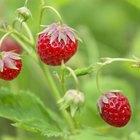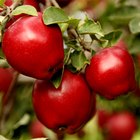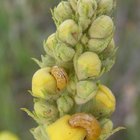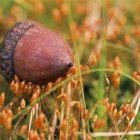A handful of ripe raspberry fruits in summer is a tasty reward for your care of raspberry bushes (Rubus spp.) throughout the growing season. The bushes, which grow as perennials in U.S. Department of Agriculture plant hardiness zones 2 through 7, depending on their variety, are typically either summer-bearing or ever-bearing. Summer-bearing bushes produce one fruit crop, which ripens in summer, while ever-bearing types produce a summer crop and a fall crop. The care requirements of both types are similar, with the exception of pruning, for which they receive very different treatments.
General Maintenance
Sprinkle 1/2 cup of 10-10-10, granular fertilizer on the soil around each raspberry bush. Apply the fertilizer in spring after the bushes' new stems, or canes, emerge from the soil.
Water the soil once each week when no rain, or not enough rain, falls. Ensure the bushes receive 1 1/2 inches of water each week from rain and/or irrigation. Spray the water slowly on the soil, avoiding wetting the plants' leaves, until the soil is damp to a depth of 6 to 8 inches.
Spread mulch on the soil surface under each raspberry bush in spring or fall. Lay the mulch 2 to 4 inches thick, leaving 2 inches of space between the base of the canes and the edge of the mulch. Straw, pine needle or sawdust mulch works well for raspberries.
Pull weeds by hand throughout the growing season. The best time to pull weeds is after a rainfall or after watering, when the soil is damp.
Pruning Methods
Summer-Bearers
Prune summer-bearing raspberry bushes selectively in the fall after the final harvest. Cut down canes that produced fruits that year. Once a cane produces fruits, it dies back anyway. Take out canes that are brown and woody. Take out canes that grow sideways, and cut broken canes below their breaks.
Ever-Bearers
Prune ever-bearing raspberries in the fall after the last harvest. Cut or mow all the stems down to the soil line. Use a lawn mower to cut a large area of the bushes. If the area is small and contained, cut the canes with a pair of handheld pruning shears. Rake up the removed material, and dispose of it to minimize the chance of diseases and pests lingering in it over winter.
Pest Identification and Treatment
Fruit-Eating Pests
Raspberries attract raspberry fruitworms and sap beetles. The yellow or tan larva of raspberry fruitworms mature into 1/2-inch-long caterpillars. They develop into 1/8-inch-long, pale-brown, hairy adult beetles. Pick the larva and adults from raspberry plants by hand. Crush the adults and larva to kill them before disposing of them in the garbage.
Sap beetles are typically 1/4 inch long and black with four orangish-yellow patches on their backs. They feed on ripe and overripe raspberry fruits. Pick ripe fruits right away, and get rid of rotten fruits from the canes and surrounding ground. Pick off and kill sap beetles.
Leaf-Eating Pests
Cutworms -- 1- to 2-inch-long, brown caterpillars -- eat raspberry leaves. Remove cutworms by hand as soon as you see them. The best way to find these leaf-eating pests is with the help of a flashlight at night, when they are most active.
Aphids suck sap from raspberry leaves, eventually weakening the plants. Look closely at the underside of leaves to spot these pests. Aphids, which are 1/32 to 1/8 inch long, typically feed in groups and are green, white, brown or black. Look for curling leaves as an indicator of aphids' presence. Get rid of a small aphid infestation by wiping or washing the affected leaves daily with water until the infestation is eradicated. When manual aphid control doesn't work, use a ready-mixed insecticidal soap spray. Wet the affected leaves -- thoroughly saturating the aphids -- once each week with the insecticidal soap until no more aphids or symptoms of aphids appear. In general, insecticidal soap can be used until one day before harvest, but follow the directions on your insecticidal soap's label.
Mold Prevention and Treatment
Seeing your ripe raspberry fruits turn moldy on the vines may be disheartening, but you can take steps to minimize the damage. The moldy fruits are often the result of gray mold. Pick off and discard moldy fruits and leaf parts to minimize the mold's spread.
Also to minimize gray mold:
- Water only at the soil line, keeping raspberry leaves and fruits as dry as possible.
- Pick ripe fruits right away.
- Rake up and discard old canes after pruning at the end of the growing season.
- Remove leaves, weeds and other plant debris from inside and around the raspberry patch.
Related Articles

What Causes Strawberries to Mold?

How to Grow Spider Mums

What Is White Squash?

How to Dry Papaya Leaf for Tea
When Is Grapefruit Season in Florida?

When Are Red Delicious Apples Ripe?
How Long Is it Safe to Keep Frozen ...

How Are Strawberries Processed?

What Foods Attract Maggots?

How to Keep Mosquitoes Away When ...

Are Buckeyes & Chestnuts the Same?

How to Grow an Oak Tree From an Acorn, ...

How to Avoid Woodpeckers at a ...
How Do I Clean Water Cress?

What Plant Do Caraway Seeds Come From?

How to Freeze Peaches With Lemon Juice

Why Do Banana Peels Turn Brown?

List of Wild Edible Plants & Berries in ...
How to Wash Fresh Fruit With Peroxide

How to Prevent Bananas From Browning ...
References
Writer Bio
Eulalia Palomo has been a professional writer since 2009. Prior to taking up writing full time she has worked as a landscape artist and organic gardener. Palomo holds a Bachelor of Arts in liberal studies from Boston University. She travels widely and has spent over six years living abroad.